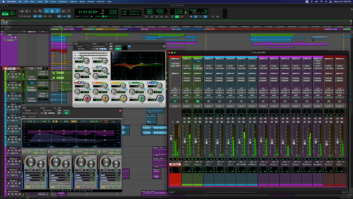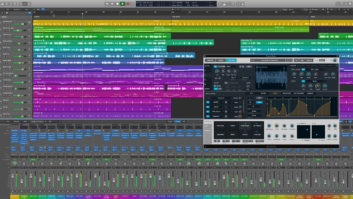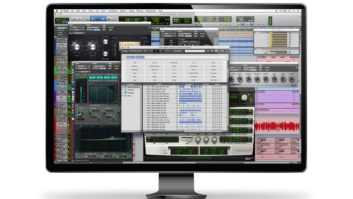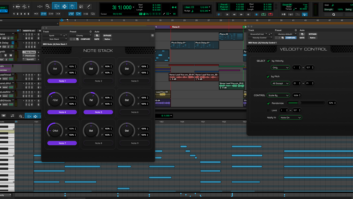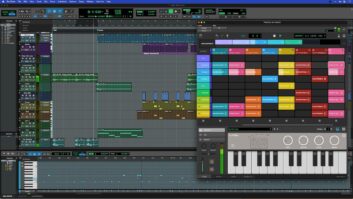In another step toward taking the Pro Tools platform to the next level, Digidesign offers a major revision of its Pro Tools digital audio workstation software. The upgrades in this new version are few in number, but they are major in scope, with several new editing tools, a refined user interface, optional video media support, MIDI sequencing and some system extension refinements that improve overall performance. For this review, I focused on music editing and MIDI features.
AT THE STARTING BLOCK
Pro Tools 5.0 comes on a new installation CD-ROM-no online upgrade is available. Users who bought Pro Tools|24 MIX or MIXPlus systems after April 19, 1999, are eligible for a free upgrade. Otherwise, it costs $199. As a bonus, buyers of a new MIX system receive a free TDM MIXpack consisting of Digidesign’s D-Verb, Focusrite’s d2 and Dynamics by Drawmer. Purchasers of MIXPlus systems also receive Focusrite’s d3, Line 6 Amp Farm and Access Virus. (The first TDM-based virtual synthesizer, Virus is awesome!)
Installation is routine. Double-click the installer application on the CD-ROM, and a Pro Tools 5.0 folder is created on your hard drive. (I installed the program on a Mac G3 266MHz desktop model outfitted with a 24 MIXPlus system.) Drivers and extensions are updated automatically, no hassles. However, the preference settings from my old version were not copied over. Unaware of this, I began using 5.0 and wondered why things weren’t responding normally (e.g., insertion points acted oddly, synchronization was off, missing I/O labels, etc.). Fortunately, I still had Version 4.2 installed; that was handy as a reference to remember my preferences, which I manually re-entered into the new software-a bit of a pain.
Digidesign’s ProControl worked fine with the new version and was a breeze to set up-simply enable ProControl in the Peripherals window and you’re ready to roll. Getting Mackie’s HUI to function properly was a little trickier. I set up HUI as a MIDI controller in the peripherals, as usual, but Pro Tools wouldn’t respond, reporting that it was “unable to communicate with HUI.” Turns out, with the new MIDI features, HUI must also be selected as an input device under the Input Device menu (which you’ll find in the main MIDI menu, a new item on the menu bar). Once I had done this, HUI performed flawlessly. This scenario will be the same for any MIDI controller.
A new version of TrackTransfer, Version 2.1, is installed with Pro Tools 5.0. I depend heavily on TrackTransfer to swap tracks between sessions. Unfortunately, Version 2.1 doesn’t recognize sessions created with Pro Tools versions earlier than 5.0. In order to use TrackTransfer on older sessions, they must first be converted to 5.0. To do this, open the old session in 5.0 and execute a Save As-conversion is automatic.
BETTER BY FAR
There are several significant, though inconspicuous, interface improvements that make the program a lot easier to operate. To begin, the Smart Tool button has disappeared, replaced by a small, space-efficient, bar beneath the Trimmer, Selector and Grabber tool buttons. Hitting this bar highlights all three icons and turns the cursor into the Smart Tool-pretty smart.
The Trimmer, Grabber and Pencil tool buttons now sport sub-menus. Clicking and holding the button opens up the tool’s options. Grabber modes include Time (the standard mode), Separation (the selection is cut at the same time it’s moved), or Object (moves only the object selected, regardless of whether or not the track is part of a group). The Pencil has five different drawing modes, from Freehand (the old standard), to Line (straight lines only), and Random (for way-out designs). In addition to the regular Trimmer mode, there’s Scrub (which trims and scrubs simultaneously) and TCE (the appropriate amount of time compression or expansion is applied to the selection to make it fit to the trim location-way cool). The new Trimmer and Grabber modes function in tandem with the Smart Tool, making the Smart Tool extremely flexible.
Multiple timeline rulers can now be displayed simultaneously (e.g., hours:minutes and bars:beats), in the Edit window. Location markers are visible on their own dedicated ruler, complete with names. The bright yellow markers are easy to see and can be freely dragged about. (Indeed, they’re so easy to move, a way to lock their positions down would be nice.) A large Main counter and smaller Sub counter are seen in both the Edit and Transport windows. Each counter can show all available time formats, independent of the other. Discrete Grid and Nudge displays let these two functions operate separately. For example, Grid could be set to whole notes and Nudge to a single millisecond. This is excellent for dialing in “a feel” during music production.
Digidesign 1622 I/O support has been added to the Playback Engine Setup. Once selected as an interface, the 1622’s gain is controllable directly via a 0dBV to +18dBu A/D input reference level mixer under Other Options. The 1622’s 11/44-inch I/Os are particularly nice for keeping synthesizers and other line-level instruments normaled to Pro Tools, negating the need to run everything through a mixing board-perfect for project and pro studios alike-I love it.
Import, capture and playback of Avid video media is now available (for Mac), in the form of a hardware upgrade, AVoption, which retails for $7,995. DigiTranslator, Digidesign’s OMF (Open Media Framework) application, which converts Pro Tools session files to OMF files (or vice versa), for compatibility with other media workstations, is free with the purchase of AVoption. (The software by itself is $495.) And speaking of different media formats, an MPEG3 export option, MP3 Export, is available as a download online for an affordable $19.95.
Greatly improved DSP handling is high on my list of favorite improvements. With the aid of several System Extension updates-in particular, DSP Manager 1.1-DSP allocation is, generally, faster and smoother. With older Pro Tools versions, trying to reload a session jam-packed with plug-ins was, often, asking for trouble; there were moments with Version 4.2 when the software refused to open a session until I played plug-in shuffleboard with the DAE Plug-Ins’ folder in order to fool the DSP Manager-an awful waste of time. No such problems with 5.0: It opened every session I threw at it, even old 4.2 sessions with tons of plug-ins. In fact, the old 4.2 sessions that showed no DSP available registered as having DSP to spare in Version 5.0.
MIDI MACHINATIONS
The new MIDI features are very intuitive. If you’re familiar with the way most software sequencers operate, you’ll feel right at home with Pro Tools’ MIDI tracks. However, as Digi’s first foray into the world of MIDI sequencing, Pro Tools is missing some of the goodies (e.g., groove controls, remote control SysEx templates and Control Change message transform functions) hard-core users have come to expect from the more established platforms. The good news is, all the essential tools are there to cut solid MIDI tracks at over 960 ppqn (according to Digidesign, the actual sequencer engine is 960,000 ppqn) for sample-accurate audio-to-MIDI timing, but 960 ppqn is the user interface resolution. Pro Tools can even import/export standard MIDI files, for doing advanced sequencing in another application and then simply importing tracks into Pro Tools. I tried this and it worked great.
Editing functions are nicely implemented. Quantize can be applied to a selection or at input in a variety of note values, from whole notes to 64th notes, dotted and triplet values. Swing, offset, strength and randomize parameters are available. Note ranges are easily selected, split and transposed. Velocity and duration can be manipulated, scaled and faded with custom curves.
The recording modes are replace and merge; either mode will operate in loop. Recording will follow countoff or wait for first note, your choice. The countoff is user-definable, and the click can be assigned to any MIDI instrument in your OMS Studio Setup-I prefer an internally generated click, as it’s easier to deal with. An input filter lets you select what kind of MIDI information is ignored. (The stock setting has polyphonic and mono aftertouch checked.)
Meters and tempos are adjusted using the Tempo and Meter Change windows-pretty straightforward. Also, the old Identify Beat feature is still available under the Edit menu. As another alternative, turn the Conductor icon “off” in the Transport bar to enter the Manual Tempo mode. In this mode, you can type in a BPM, use the slider element or hit the Tap button to change a session’s global tempo. Both tempo and meter now have discrete rulers that are seen simultaneously with the timeline rulers.
MIDI tracks in both the Edit and Mix windows look almost identical to audio tracks: The user interfaces are the same; the only difference is the way the information is displayed. In the Edit window, notes are seen in place of waveforms and controller information in place of automation moves. MIDI tracks appear as input channel strips in the Mix window. The LED meter is turned into a dynamic MIDI activity light. Of course, the MIDI channel strips don’t have plug-in slots-although MIDI plug-ins (e.g., arpeggiators, delays, controller templates, etc.) aren’t such a bad idea. The New Track command used to make audio tracks is also used for creating MIDI tracks.
Overall, MIDI timing was rock-solid. However, I did encounter some MIDI log jams while using Pro Tools with HUI. When several MIDI tracks were playing, and I was, for example, tweaking a plug-in via HUI, MIDI playback would hiccup. The hiccup would only last a split second and then everything would lock back up, but it was long enough to disturb the groove (especially when trying to cut a take to the virtual tracks). I’m not sure what the ideal solution is for this situation, disable HUI or turn the virtual tracks into audio tracks, but either way, it isn’t impossible to work around. (Digidesign says there were some software driver problems with MOTU’s MTP AV, the interface I was using, which might have caused the hiccups.) If you can afford ProControl, maybe this is the way to go, because it isn’t MIDI-based and won’t clog the MIDI lines. (Perhaps Digidesign could make a less expensive ProControl for financially challenged folks like myself.)
UP, UP AND AWAY
This latest version of Pro Tools is super; better DSP management, more editing tools, a refined user interface, added media and hardware compatibility and MIDI sequencing as a bonus. Whether you’re into music production or post, there’s something in Version 5.0 sure to tickle your fancy. And if this isn’t enough, DirectConnect (available for free download at Digidesign’s Web site) opens up a whole new world of native instruments (e.g., Koblo’s Studio9000) for plugging right into your Pro Tools mixer.
Digidesign, 3401-A Hillview Avenue, Palo Alto, CA 94304; 650/842-7900; fax 650/842-7999. Web site: www.digidesign.com.
A palette of MIDI parameters is one of the new additions to Pro Tools 5.0. The following MIDI menu items are well implemented, providing a variety of editing and recording options.
Change Tempo
Change Meter
Quantize
Change Velocity
Change Duration
Transpose
Select Notes
Split Notes
Input Quantize
Click
Click Options
MIDI Beat Clock
Input Filter
Input Devices
MIDI Thru
All Notes Off
